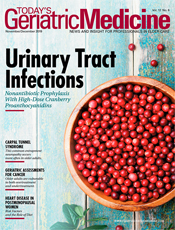
November/December 2019
From the Editor: New Respect For a Folk Remedy Urinary tract infections (UTIs) plague more than one-half of women at some point in their lifetimes. Although they’re four times more common in women, men suffer as well, and often more severely, with greater likelihood of complications. Because these infections tend to recur, can have serious repercussions, and are treated with antibiotics, there’s an urgent need for preventive measures to stem the infections and reduce antibiotic resistance. UTIs are particularly prevalent—and typically more virulent—in older adults, particularly those who dwell in long term care facilities or have had hospitalizations that have exposed them to bacteria. Other risk factors for older patients include incontinence, a history of UTIs, immune system changes resulting from aging, and conditions or illnesses involving the urinary tract or causing urinary retention. Younger patients may experience typical symptoms including urinary urgency, blood in the urine, pain or burning with urination, fever, flank or back pain, fatigue, nausea, and vomiting. Older adults may experience additional symptoms including some that mimic those of other conditions, such as dementia, which can complicate diagnosis. Among these are confusion, delirium, or sudden changes in behavior (eg, agitation restlessness), and confusion. And complications may include kidney damage and potentially life-threatening sepsis. Treatment involves the use of antifungals for those whose infections are caused by a fungus, and antibiotics for those caused by bacteria. And while treatments are effective, UTIs tend to be recurrent, and repeated use of antibiotics contributes to antibiotic resistance. It’s not uncommon for physicians to prescribe antibiotics for asymptomatic individuals who have bacteria in the urine; this is neither necessary nor helpful. To help prevent antibiotic resistance and to avoid unnecessarily subjecting patients to side effects and consequences of antibiotics, it’s important that clinicians prescribe antibiotic treatment only to individuals with symptoms, rather than base treatment on elevated urinary bacteria. Prevention methods have included remaining well hydrated, scheduling urination, reducing the amount of time catheters are used, and proper toileting and incontinence hygiene. But clearly something more is needed. As Sophie Fletcher, MD, writes in this issue’s cover story, “As the population ages, the overall UTI burden will go up too, requiring new approaches and multidisciplinary strategies to improve the diagnosis, treatment, and, most key, prevention strategies to optimize elder care.” She explores the research that’s confirming what folk wisdom has long suggested—that a component of cranberries can go a long way toward stemming the development and recurrence of UTIs and complications in millions of older adults while addressing antibiotic resistance. |
